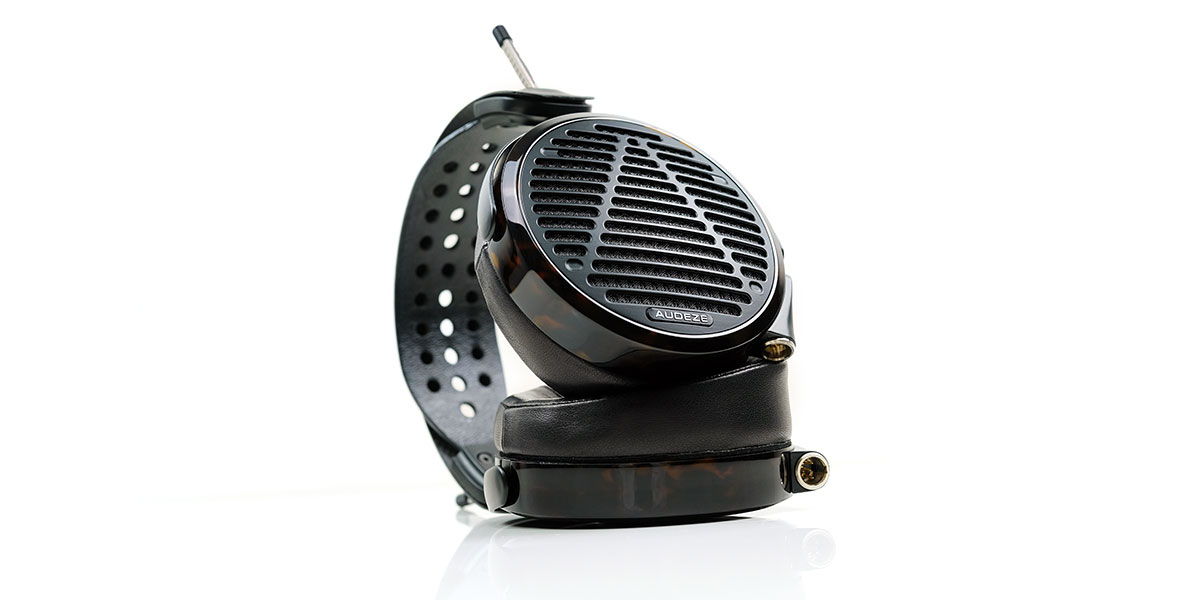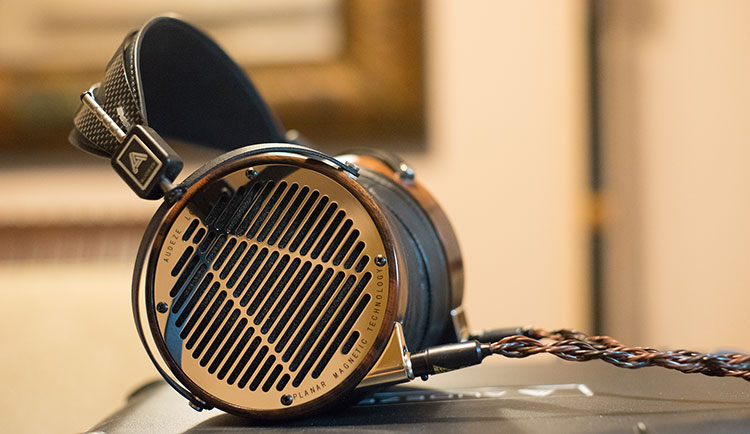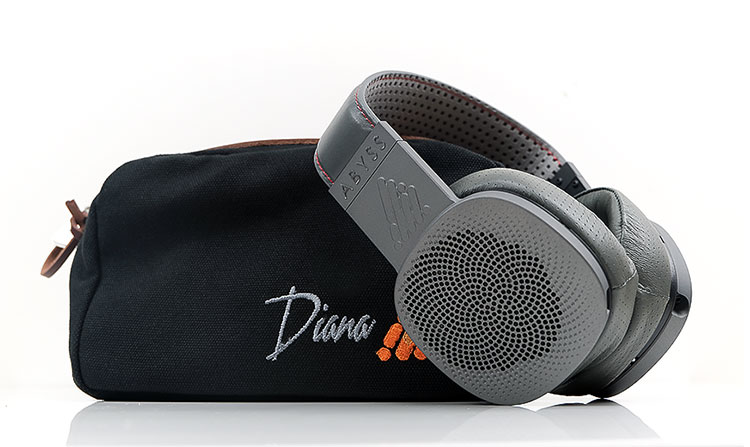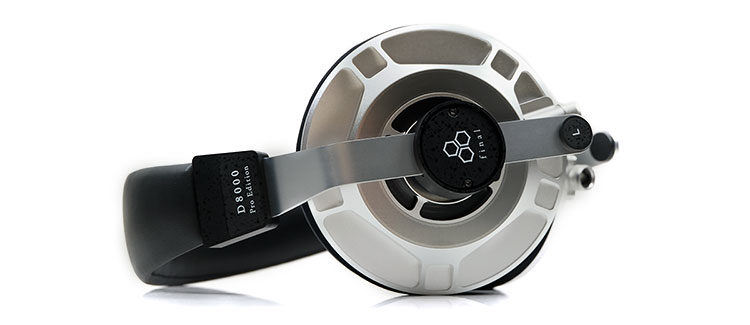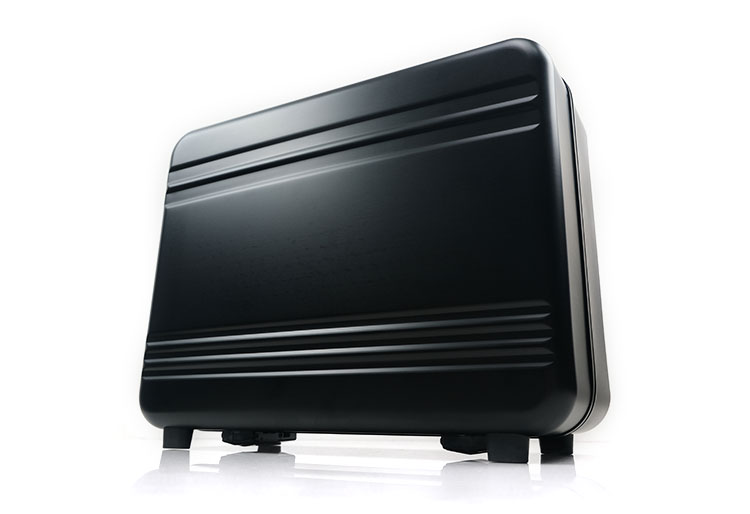Select Comparisons
Comparison testing was completed using a Ferrum OOR balanced amplifier linked to a Hypsos hybrid power system with the Holo Audio Spring DAC 2 Wildism Edition DAC.
Audeze LCD-4
$3995 (Currently out of stock)
The LCD-4 was the long-time flagship of the LCD Series for around 5 to 6 years going back to late Oct 2015 when it was first announced. Originally, this was a short-lived 100Ω and 100db SPL-rated headphone with some driver issues that morphed into the current 200Ω/97dB SPL standard as a long-term stable remedy.
Technical
Big changes on the inside with the LCD-4 using a larger 106mm driver compared to 90mm inside the LCD-5. Both use nano-scale thick diaphragms with Fluxor magnet arrays, however, the LCD-4 uses a double magnet array and a less efficient trace pattern on an older voice coil design making it a heavier assembly and less efficient.
The LCD-5 uses the new Parallel Uniforce voice coil implementation with multiple-width trace patterns on the diaphragm and a longer voice coil to keep the impedance low and retain a higher voltage headroom. Thus, the LCD-5 ultra-low 14Ω impedance rating.
The Fazor implementation has also changed with a lower profile inside the cup compared to the LCD-4 that prevents your ear from any accidental sharp contacts as well as further reduce soundwave diffractions.
One thing to note is the SPL, however, with the LCD-5 a good deal lower at 90dB SPL compared to the 97dB of the LCD-4. So, whilst the load is much lighter now and it is easier to drive, you will still need an amp that has a very good current performance.
Design
Both are clearly LCD headphones from afar but that’s about it with almost every aspect of the LCD-5 engineering design improved the older more traditional LCD-4 approach. For one, the LCD-5 is lighter by 270g which makes a huge difference in terms of vertical pressure relief on the head. Even just handling the LCD-5 is much easier than the LCD-4.
The wood and chrome grills are gone, replaced by that ‘Tortoise Shell’ acetate enclosure and black grill finish. The pivot blocks and wide carbon fiber arch system has been phased out for a more discreet and lighter rod adjustment system with a narrow but thicker carbon fiber band and perforated leather pressure strap styling.
The magnesium gimbals are also more ‘aerodynamic’, closer to the enclosure, and the matching mini-XLR connectors create a very streamlined aesthetic without getting in the way of the cup’s articulation. Finally, the LCD-5 leather earpads are slightly lower profile and convex sculptured compared to the more traditional big thick leather pads on the LCD-4.
Vertical pressure and weight are very much in favor of the LCD-5 in terms of comfort but I give the nod to the LCD-4 for lateral pressure comfort. The final observation is the switch to OCC pure copper from SPC in the cable wiring and a slightly tighter finish around a smaller jack barrel.
Performance
The LCD-5 is definitely the more coherent and smoother sounding of the two. Particularly in the mids and treble where Audeze has completely rethought the tuning in terms of finding an agreeable harmonic balance.
I often think of the LCD-4 as a game of two halves. A smooth voluptuous deep pure planar bass reaching right down to 20Hz effortlessly and that classic Audeze slow rise to around 1-2k giving excellent prominence to lower pitching instrumentals with a solid fundamental. Vocal presence has a decent platform but is not overly pushed or shouty.
Beyond, however, the upper-mids to treble transition is less smooth with a striking dip in the lower treble and some peaking around 8k or above creating a bit of a metallic aftertaste and more contrast in higher pitching percussion passages, as well as some dissonance in high-pitching voice recordings.
The LCD-5 is like a breath of fresh air to me personally when comparing it to the above. The treble is a lot smoother with no narrowband spikes around 8-10k bearing down on the upper mids and lower treble timbre. You might find it more relaxed sounding but trust me, it is a worthy trade-off in terms of coherency.
Less of a strain to create faux detail with overemphasized shimmer or sparkle means a more agreeable harmonic balance on those all-important upper-mids for me. That allowed Audeze to be a bit more aggressive with the mids tuning on the LCD-5 in terms of focus with better texture for that matter and without that treble biting too much into its tonal character.
The bass weight has come off a degree or two from the LCD-4. It is not as emphasized but tighter sounding on the LCD-5 helps to create a bit more space for the mids to shine.
Abyss Headphones Diana Phi
$3995
We covered the ‘pocket rocket’ that is the Abyss Headphones Diana Phi back in mid-2019 and it walked off with our Top Gear Award for Best Headphones in 2019. Though it is not the Abyss top-dog the pricing is not too far off the LCD-5 either.
Technical
Size is the main game here with the Diana Phi, with a smaller 63mm ‘phi-planar’ driver with an ultra-low mass diaphragm and a single-sided magnet array but one which is much the same as the driver used in the higher-end AB-1266 Phi CC.
The LCD-5 planar driver size is smaller than before but still quite a bit bigger at 90mm and I suspect could also be defined as using an ultra-low mass diaphragm with its nano-scale thickness.
Like the Diana Phi, the LCD-5 is also a single-sided array build but we know less about the Phi driver engineering beyond that it uses neodymium magnets in an optimized slot pattern. We know a lot more about the Parallel Uniforce voice coil system, the improved low-profile Fazor implementation, and the Fluxor magnet technology behind the LCD-5.
In terms of efficiency, the Diana Phi is rated a little higher at 32Ω for load but has a similar rating of 91dB SPL compared to the 14Ω and 90dB SPL of the LCD-5.
Tested with the SE output of the Ferrum OOR desktop amp, the Diana Phi did need a little more juice to volume-match the LCD-5 which may allude to the variation in the load demand since the dB SPL rating of both headphones are almost the same.
Design
In terms of size and weight, it is hard to argue with Diana Phi’s ultra-compact form factor. The Abyss moniker of “thinnest boutique headphones” in the world is not for nothing. Weighing in at 330g compared to the LCD-5’s 420g and smaller, the Phi does win the award for flagship ‘portability’.
The designs used in both headphones deliver very different vibes to me. The Diana Phi goes for a retro-70s styling with that Fibonacci pattern finished gunmetal colored aluminum frame. The LCD-5 is more ’40’s Noire’ with its turtle shell acetate finish, low-profile black grills, and the big A logo stretching across it.
There are no moving parts either in the Diana Phi design yet the headband design itself is flexible enough to shape around most people’s heads. It is not stiff like the Hifiman Ananda or Sundara designs but does not have the same nuanced vertical and lateral control as the LCD-5.
Both use sculpted pad designs but the LCD-5 options are more comfortable than the original Phi pads. Abyss did change them to the version found on the Diana V2 which closed the comfort gap somewhat. However, Diana Phi’s lean headband design produces a more noticeable vertical pressure contact point. You get none of that with the comfier LCD-5 pressure strap.
Performance
These two headphones complement each other rather than compete. The tonal coloration is very different and where your ear is drawn to in terms of presence is also fairly contrasting.
Much of these differences come from the variations in the mids and treble tuning. Both the Phi and the LCD-5 have a rising mid-range from a relatively flat bass response that for the Phi peaks at around 2k.
However, from there, the LCD-5 keeps the mids further forward up to around 5k, whereas the Diana Phi dips from 2-5k. The Phi also has a lot more treble energy from 5-8k and a secondary 10k bump compared to the more relaxed LCD-5 treble performance.
The Diana Phi thus has a more odd-harmonic timbral bias creating a cleaner lighter tone and a heavier emphasis on perceived articulation. Of the two headphones, the Diana Phi will come across as airier, more neutral, but also less forgiving of bad recordings.
The LCD-5 sounds rounded and smoother, with a stronger fundamental and a more even-harmonic balance. Actually, the LCD-5 sounds comparatively analog in tone with less treble sparkle and shimmer compared to the Phi.
That is one reason why I said at the start each headphone will guide your focus to different characteristics of instrumental and vocal notes. The second is the staging bias. For me, the Phi has a ‘top-down’ staging quality. That dip in the mids and stronger treble extension enhance perceived space above and around the performance stage.
The LCD-5 pulls it in a bit, with more rounded staging quality, a front and center vocal focus, as well as weightier bass to lower-mids presence. The relaxed treble energy means your ear is further down and right at the stage level with the power and body more convincing.
Final D8000 Pro
$4299
The flagship Final D8000 Pro was reviewed by yours truly earlier this year and I rate it as a planar magnetic headphone with a world-class performance as well as a price point not too far off the LCD-5.
Technical
Inside, the D8000 Pro does not have a particularly large planar driver at 50mm, (moving part), versus 90mm inside the LCD-5. It also uses a double-sided magnet array as opposed to the 14-magnet Fluxor magnet single-sided array inside the LCD-5.
Both headphones have a very unique approach to how the diaphragm is implemented with Audeze using their new Parallel Uniforce system and Final with their AFDS implementation.
AFDS stands for Air Film Damping System and basically is ensures there is zero contact between the diaphragm and the magnet array when active to enhance ‘bass purity’ or reduce distortion. The use of air film between the magnets acts like an air buffer and cushions the diaphragm in such a way as to reduce the level of contact with the magnets
Audeze’s approach to keeping distortion low is the Parallel Uniforce coil system’s varying width trace dimensions and varying current density levels that increase voltage headroom by altering the current density within each trace. Improved control over the diaphragm and even force applied also mean a lower level of distortion in the LCD-5 driver.
Audeze’s approach also means a lighter load so the rating is much lower at 14Ω compared to the more resistive 60Ω from the D8000 Pro. However, the D8000 Pro SPL is easier going at 98db SPL compared to the LCD-5’s 90dB rating meaning it is more current sensitive requiring less volume on amps with a good voltage swing.
Design
I prefer the sleeker modern design of the LCD-5 and I do think it has an edge in terms of engineering quality also. The D8000 Pro has a nice retro-vibe to its aesthetic but it has more of a traditional approach to planar headphone design weighing in at a heavier 523g.
Much of the D8000 Pro’s additional weight I suspect is in that aluminite anodized magnesium alloy frame and dual magnet array inside. The cups are bigger than the LCD-5 acetate cups despite housing a smaller 50mm diver which does add to the weight.
The D8000 Pro uses a classic single spring steel headband system covered in copious amounts of leather-wrapped memory foam which is reasonably comfortable but does have a narrow contact spot compared to the LCD-5’s wider pressure strap system.
That is a factor as the D8000 Pro’s additional weight and softer clamping create more vertical than lateral pressure and some minor pressure hotspots on the scalp compared to the LCD-5. It’s not an uncomfortable spot like the Gen 2 LCD headbands (circa 2011) but you are more aware of it.
Clamping is more relaxed compared to the LCD-5 but I think the breathable Toray Ultrasuede pads on the D8000 Pro let it down a little with some contact pressure despite having a broader contact surface.
I do like the styling and performance of the additional 3m D8000 Pro high-purity OFC silver-coated cable but it is a heavier cable than the 2.5m OFC wired 20AWG version that comes with the LCD-5. Both are terminated as SE out of the box.
Performance
The D8000 Pro has a neutral to slightly sweeter-sounding tone and an airier staging quality compared to the weightier and more rounded timbral quality of the LCD-5. The key difference that teases out that cleaner overtone in the Pro is the mids and treble tuning.
The Pro’s mids emphasis is positioned a little higher around 4-6k rather than the LCD-5’s 3-4k peak and it does sound it is picking up more upper treble energy compared to the more relaxed curve of LCD-5’s treble.
The timbral balance on the Pro delivers a higher level of contrast and a harder edge in the percussion timbre whereas the LCD-5 is smoother and fuller sounding over the same region.
The sub-bass extension is not as dramatically different with both running a fairly linear and deep bass response. However, the LCD-5 has a nuance bump in the mid and upper bass offering a bit more warmth from 100-300Hz.
Both also rise from the lower mids into the 1-2k zone but the D8000 Pro is coming from a position just slightly south of the Harman Curve and the LCD-5 is consistently closer or a little bit above the curve to that 2k marker.
You will hear a stronger instrumental presence and a bit more warmth and physicality in the LCD-5’s lower mids. Not that the Pro lower mids are recessed, rather their positioning is a little more neutral as is their tone and weight.
The 1-3k zone is very linear and flat on the Pro so it takes on more of a reference tone and is less emotive than the LCD-5 mids. The LCD-5 is more forward sounding over the same region carrying a little more warmth and body into vocals, particularly female vocals which are more intimate and smooth sounding.
Our Verdict
We have been incredibly spoilt by the amount of quality flagship headphone performers released this year and the LCD-5 is no exception.
The new driver and internal engineering inside the LCD-5 have allowed the team a bit of freedom from previous constraints to tackle some of the flaws from the LCD-4 but at the same time create an entirely new tonal profile.
Certainly, it’s the most mature-sounding and cohesive high-end Audeze headphones to date. Importantly, it is their most likable tuning with plenty of verve and character and absolutely excellent levels of detail to go along with it.
Not everything is perfect though. I love the new external design and my goodness the improved weight is just excellent. However, the current clamping and narrow surface contact area of the new pads might create a comfort issue for some. I suspect the future option to order a larger headband when buying the LCD-5 will remedy that for those who prefer it.
Fitting options aside, the LCD-5 reminds me of why I jumped on the original LCD Series all those years ago. This is a high-quality sound with verve, beautiful character, and soul.
Audeze LCD-5 Specifications
- Magnetic structure Fluxor™ magnet array
- Phase management Fazor™
- Magnet type Neodymium N50
- Diaphragm-type Nano-Scale Parallel Uniforce™
- Transducer size 90 mm
- Maximum SPL >130dB
- Frequency response 5Hz – 50kHz
- THD <0.1% @ 100 dB SPL
- Sensitivity 90 dB/1mW (at Drum Reference Point)
- Impedance 14 ohms
- Max power handling 5W RMS
- Min recommended power > 100mW
- Recommended power level >500mW
- Weight 420g




